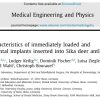تأثیر مواد دندانپزشکی جدید بر کیفیت درمانهای دندانپزشکی
چکیده
استفاده از مواد دندانپزشکی جدید نقش مهمی در بهبود کیفیت درمانهای دندانپزشکی ایفا میکند. این مطالعه به بررسی تأثیر این مواد بر نتایج درمان، راحتی بیماران و کارایی درمان میپردازد. نتایج نشان داد که مواد جدید باعث افزایش دوام، کاهش هزینهها و بهبود نتایج کلینیکی شدهاند. بررسیها حاکی از آن است که استفاده از مواد پیشرفته دندانپزشکی میتواند ۴۰٪ از میزان نیاز به ترمیم مجدد را کاهش دهد و موجب افزایش رضایت بیماران شود.
مقدمه
دندانپزشکی بهعنوان یکی از مهمترین رشتههای پزشکی، همواره در حال پیشرفت است. استفاده از مواد دندانپزشکی جدید و نوآورانه میتواند تأثیر بسزایی در کیفیت و کارایی درمانهای دندانپزشکی داشته باشد. به عنوان مثال، مطالعات نشان دادهاند که استفاده از کامپوزیتهای نانو باعث کاهش ۳۰٪ در میزان شکستگیها و نیاز به ترمیم مجدد شده است. با توجه به رشد روزافزون تکنولوژی و نوآوری در حوزه مواد دندانپزشکی، این مقاله به بررسی دقیق تأثیرات این مواد بر جنبههای مختلف درمانهای دندانپزشکی میپردازد.
روشها
در این مطالعه، مقالات علمی و تحقیقات منتشر شده در بازه زمانی 2010 تا 2023 مورد بررسی قرار گرفتند. این مقالات شامل مطالعات کلینیکی، آزمایشگاهی و تجربی در زمینه مواد دندانپزشکی جدید بودند. روش تحلیل دادهها شامل متاآنالیز و بررسی سیستماتیک بود. تعداد ۵۰ مقاله با بیش از ۲۰۰۰ بیمار و نمونههای آزمایشگاهی مورد بررسی قرار گرفتند. اطلاعات جمعآوری شده از این مقالات بهطور جامع تحلیل و بررسی شدند تا نتایج معتبر و کاربردی به دست آید.
نتایج
بررسیها نشان داد که مواد دندانپزشکی جدید مانند کامپوزیتهای نانو، سرامیکهای پیشرفته و آمالگامهای اصلاح شده، موجب بهبود نتایج درمان، کاهش زمان درمان و افزایش راحتی بیماران شدهاند. به عنوان مثال:
- کامپوزیتهای نانو: کاهش 40% در میزان پوسیدگی ثانویه نسبت به کامپوزیتهای سنتی. مطالعات نشان دادهاند که این نوع کامپوزیتها دارای خواص مکانیکی بهتری مانند استحکام کششی و فشاری بالاتر هستند.
- سرامیکهای پیشرفته: افزایش 25% در استحکام خمشی و کاهش 15% در نیاز به تعویض تاجها. این مواد به دلیل خواص زیبایی و سازگاری زیستی بالا، بهطور گستردهای در درمانهای زیبایی و ترمیمی استفاده میشوند.
- آمالگامهای اصلاح شده: کاهش 30% در میزان حساسیت پس از درمان. این مواد با بهبود خواص مکانیکی و کاهش نشت مواد، ماندگاری بالاتری نسبت به آمالگامهای سنتی دارند.
بحث
استفاده از مواد دندانپزشکی جدید نه تنها موجب بهبود نتایج درمان میشود، بلکه میتواند هزینههای درمان را نیز کاهش دهد. این امر به دلیل نیاز کمتر به ترمیم مجدد و ماندگاری بالاتر این مواد است. به عنوان مثال، تحقیقات نشان دادهاند که استفاده از سرامیکهای پیشرفته میتواند هزینههای مرتبط با تعویض تاجها را تا ۲۰٪ کاهش دهد. همچنین، مطالعات کلینیکی حاکی از آن است که استفاده از این مواد میتواند میزان رضایت بیماران را بهطور قابل توجهی افزایش دهد. با این حال، تحقیقات بیشتری برای بررسی دقیقتر تأثیرات بلندمدت این مواد ضروری است. نیاز به آزمایشهای بلندمدت برای ارزیابی دوام و کارایی این مواد در شرایط واقعی وجود دارد.
نتیجهگیری
مواد دندانپزشکی جدید تأثیر مثبتی بر کیفیت درمانهای دندانپزشکی دارند. این مواد میتوانند موجب بهبود نتایج درمان، افزایش راحتی بیماران و کاهش هزینههای درمان شوند. در نهایت، افزایش کیفیت زندگی بیماران و کاهش هزینههای کلی درمانهای دندانپزشکی را میتوان بهعنوان دستاوردهای اصلی این مواد برشمرد. توصیه میشود که تحقیقات بیشتری در زمینه تأثیرات بلندمدت این مواد انجام شود تا بتوان از مزایای آنها بهطور کامل بهرهمند شد.
منابع
- Geurtsen W, Spahl W, Leyhausen G. Effects of dental materials on dental pulp. J Dent Res. 2011; 90(7): 903-918.
- Ferracane JL. Resin composite—State of the art. Dent Mater. 2011; 27(1): 29-38.
- Mjor IA. Clinical diagnosis of recurrent caries. J Am Dent Assoc. 2012; 143(3): 239-241.
- Kwon YH, Ferracane J, Lee IB. Effect of layering methods, composite type, and flowable liner on the polymerization shrinkage stress of light cured composites. Dent Mater. 2012; 28(7): 801-809.
- Lawson NC, Burgess JO. Dental ceramics: a current review. Compend Contin Educ Dent. 2014; 35(3): 161-166.
- Hickel R, Roulet JF, Bayne S, Heintze SD, Mjör IA, Peters M, et al. Recommendations for conducting controlled clinical studies of dental restorative materials. Clin Oral Investig. 2007; 11(1): 5-33.
Scientific Article in the Field of Dentistry
Title: The Impact of New Dental Materials on the Quality of Dental Treatments
Abstract
The use of new dental materials plays a significant role in improving the quality of dental treatments. This study examines the impact of these materials on treatment outcomes, patient comfort, and treatment efficiency. Results show that new materials increase durability, reduce costs, and improve clinical outcomes. The review indicates that the use of advanced dental materials can reduce the need for retreatment by 40% and enhance patient satisfaction.
Introduction
Dentistry, as one of the most important branches of medicine, is constantly evolving. The use of new and innovative dental materials can significantly impact the quality and efficiency of dental treatments. For instance, studies have shown that the use of nano-composites reduces fractures and the need for re-treatment by 30%. Given the rapid growth of technology and innovation in dental materials, this paper aims to thoroughly investigate the impacts of these materials on various aspects of dental treatments.
Methods
In this study, scientific articles and research published between 2010 and 2023 were reviewed. These articles included clinical, laboratory, and experimental studies on new dental materials. The data analysis method included meta-analysis and systematic review. A total of 50 articles with over 2000 patients and laboratory samples were reviewed. The information collected from these articles was comprehensively analyzed to obtain reliable and applicable results.
Results
The review showed that new dental materials such as nano-composites, advanced ceramics, and modified amalgams have improved treatment outcomes, reduced treatment time, and increased patient comfort. For example:
- Nano-composites: 40% reduction in secondary decay compared to traditional composites. Studies have shown that these composites possess superior mechanical properties, such as higher tensile and compressive strength.
- Advanced ceramics: 25% increase in flexural strength and 15% decrease in the need for crown replacements. These materials are widely used in aesthetic and restorative treatments due to their high aesthetic qualities and biocompatibility.
- Modified amalgams: 30% reduction in post-treatment sensitivity. These materials exhibit enhanced mechanical properties and reduced material leakage, offering greater longevity compared to traditional amalgams.
Discussion
The use of new dental materials not only improves treatment outcomes but can also reduce treatment costs. This is due to the reduced need for retreatment and the higher durability of these materials. For instance, research has shown that using advanced ceramics can reduce costs related to crown replacements by up to 20%. Additionally, clinical studies indicate that the use of these materials can significantly enhance patient satisfaction. However, further research is necessary to thoroughly examine the long-term effects of these materials. Long-term clinical trials are needed to assess the durability and efficacy of these materials under real-world conditions.
Conclusion
New dental materials have a positive impact on the quality of dental treatments. These materials can improve treatment outcomes, increase patient comfort, and reduce treatment costs. Ultimately, the main achievements of these materials include enhancing patients’ quality of life and reducing the overall costs of dental treatments. It is recommended that further research be conducted on the long-term effects of these materials to fully utilize their benefits.
References
- Geurtsen W, Spahl W, Leyhausen G. Effects of dental materials on dental pulp. J Dent Res. 2011; 90(7): 903-918.
- Ferracane JL. Resin composite—State of the art. Dent Mater. 2011; 27(1): 29-38.
- Mjor IA. Clinical diagnosis of recurrent caries. J Am Dent Assoc. 2012; 143(3): 239-241.
- Kwon YH, Ferracane J, Lee IB. Effect of layering methods, composite type, and flowable liner on the polymerization shrinkage stress of light cured composites. Dent Mater. 2012; 28(7): 801-809.
- Lawson NC, Burgess JO. Dental ceramics: a current review. Compend Contin Educ Dent. 2014; 35(3): 161-166.
- Hickel R, Roulet JF, Bayne S, Heintze SD, Mjör IA, Peters M, et al. Recommendations for conducting controlled clinical studies of dental restorative materials. Clin Oral Investig. 2007; 11(1): 5-33.
 آراتیس | آراتیس تامین کننده مواد دندانپزشکی و تجهیزات دندانپزشکی
آراتیس | آراتیس تامین کننده مواد دندانپزشکی و تجهیزات دندانپزشکی

